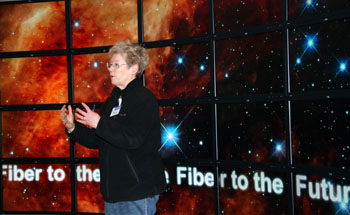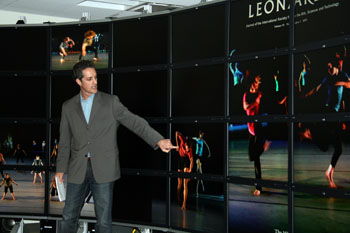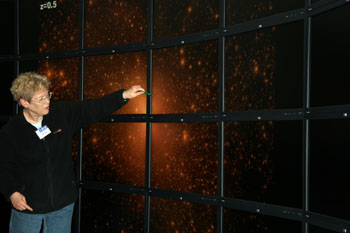The University of California, Santa Cruz, community leaders, and the Corporation for Education Network Initiatives in California (CENIC) today celebrated completion of the final link in the Fiber to the Future project that achieves a 10-fold increase in the campus's connection to CENIC's ultra-high-speed research and education network serving the state's education and research institutions.
The new fiber-optic connection now links the UC Santa Cruz campus to the California Research and Education Network (CalREN) via CENIC-owned fiber, bringing ultra-high-speed Internet performance to the Santa Cruz area and guaranteeing increased speed at very low cost over many years. CalREN, run by the non-profit CENIC, connects virtually all of California's research and education from K-12 to universities to one another and the world beyond at ultra-high-performance speeds.
The connection gives UCSC faculty, staff, and student researchers a link to this statewide research and education network that is 10 times faster than its previous access.
"The upgrading of our telecommunications infrastructure moves us to the competitive edge in network connectivity with network capabilities that rival those found anywhere," said UC Santa Cruz Chancellor George Blumenthal. "This new era on campus also ushers in a new era for the community, because this improved network is a shared resource."
"We are grateful to UCSC for taking the lead and bringing this resource to our community," said Chris Neklason, co-founder and co-CEO of Cruzio, a Santa Cruz Internet service provider.
"High-bandwidth networking of this type is a big draw for the best faculty, is an absolute requirement for some research grants, and enables cutting-edge research," said CENIC President and CEO Jim Dolgonas.
"Distributed research is often impossible without such networking, and these are all a big part of UC Santa Cruz. This new connection will play a crucial role in that. We are pleased to have been able to complete this important project for the campus and want to thank Sunesys, the firm who installed the fiber for us."
On the UCSC campus, the high-speed connection will benefit research in the sciences, engineering, social sciences, arts, and humanities. It will support the international Human Genome project, enable astrophysicists to share data-intensive models of the universe with other researchers, and power dance collaborations where performers at UCSC interact with and respond in real-time to artists in other venues.
During the celebration at the Engineering 2 building on the UCSC campus, professors Sandra Faber, astronomy, and Ted Warburton, theater arts, demonstrated some of the amazing new research and collaborative capabilities of the high-speed connection.
Background
Launched in January 2008, the Fiber to the Future project entailed stringing more than 50 miles of fiber-optic cable from the Silicon Valley to the UC Santa Cruz campus. Additional cable was extended to UCSC facilities at 2300 Delaware Ave. where they serve as a tie-in point for the Santa Cruz County community. The approximate $5 million investment was funded by UCSC and the UC Office of the President.
The high-speed network connection gives campus researchers greatly increased bandwidth and capabilities for dedicated connections to the campus's Silicon Valley Center located at NASA's Ames Research Center.
The dedicated link also protects the campus and community from reliance on commercial networks such as one disrupted a year ago when severed cables in South San Jose cut telephone and Internet service for tens of thousands of Central Coast residents.
About CENIC
The Corporation for Education Network Initiatives in California (CENIC) designs, implements, and operates CalREN, the California Research and Education Network, a high-bandwidth, high-capacity Internet network specially designed to meet the unique requirements of California's education and research communities. CalRen connects beyond California to national and international networks around the globe, providing a high-performance network path from California researchers and educators to colleagues almost anywhere in the world, and enabling innovation at levels previously considered science fiction.





